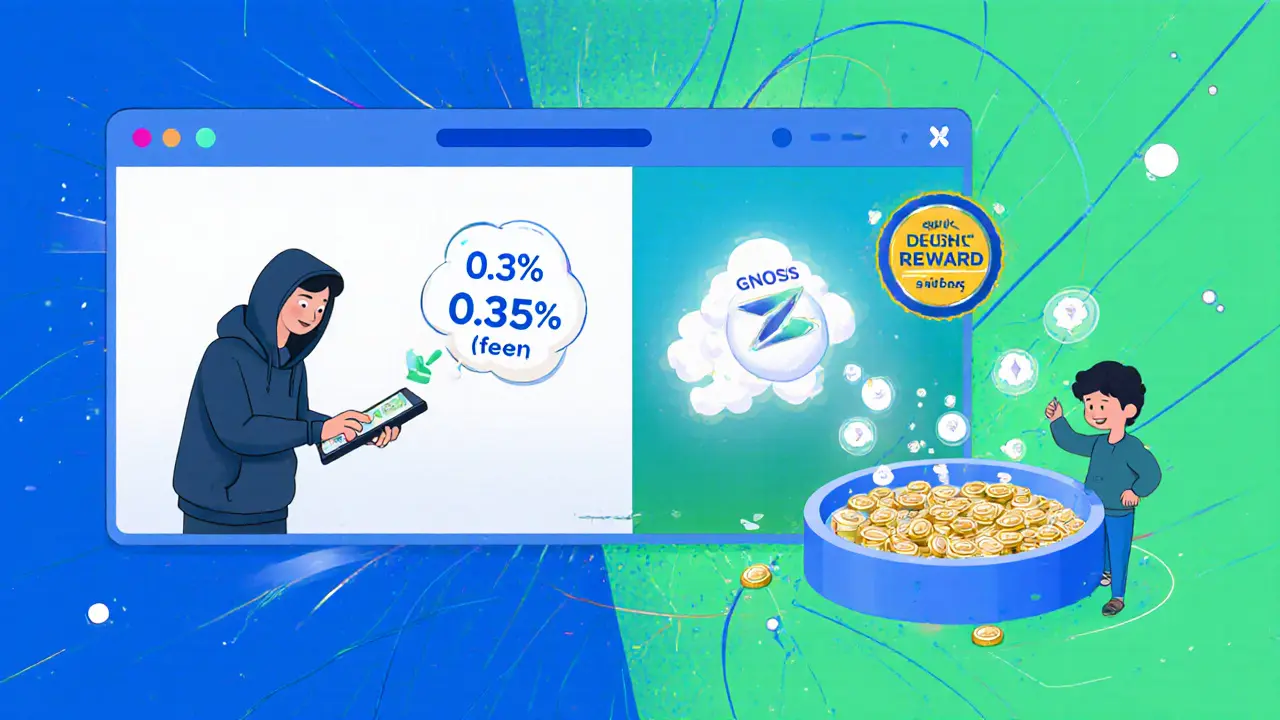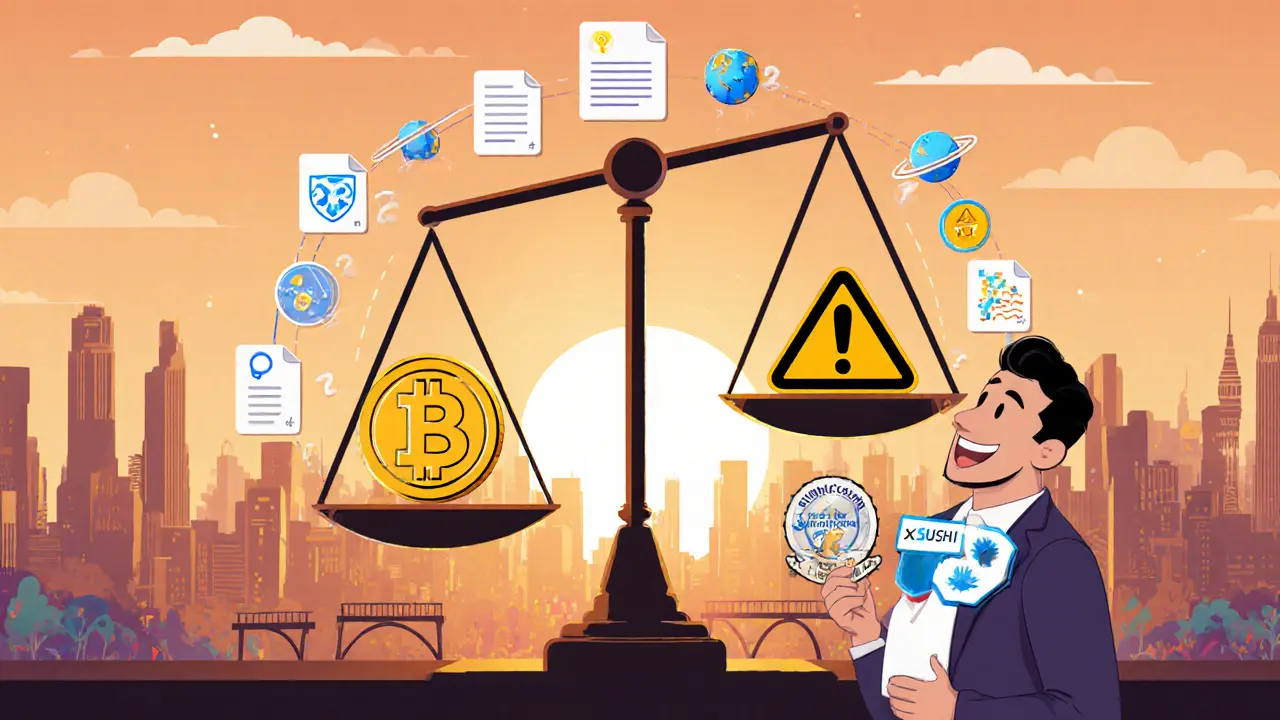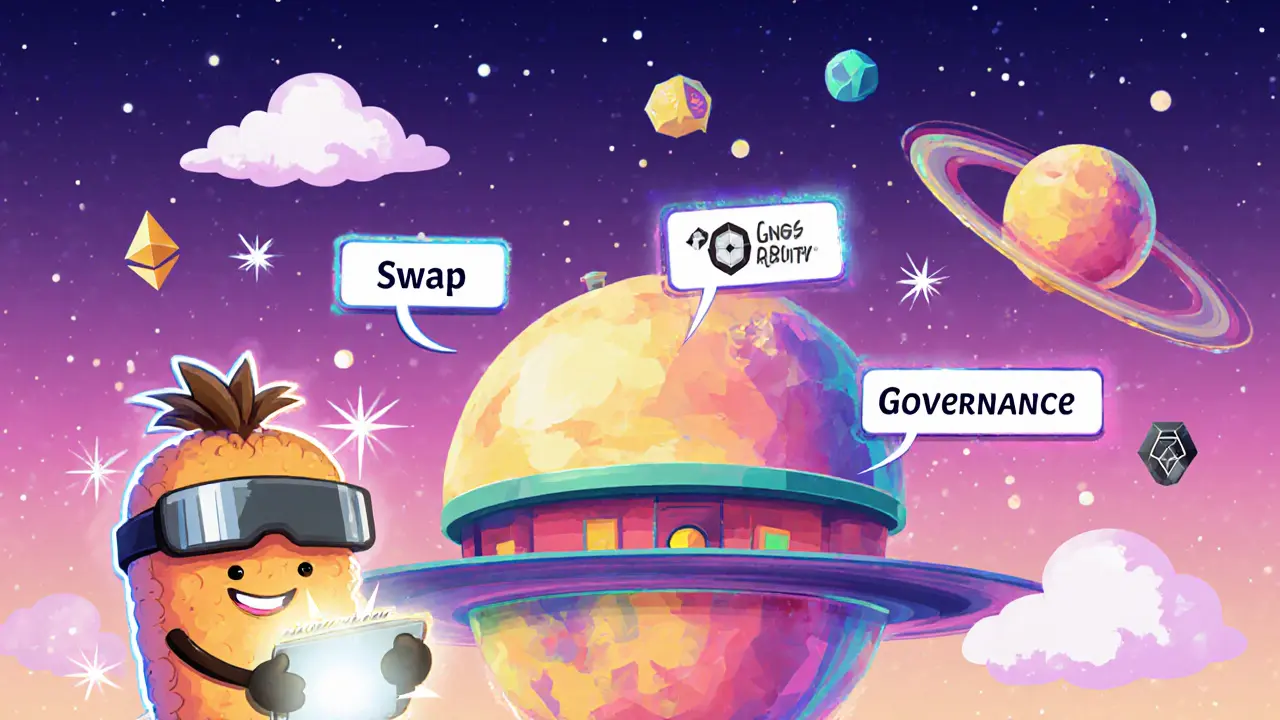SushiSwap Fee Calculator
Results Summary
When you hear SushiSwap review, you probably wonder whether the platform lives up to the hype around its community‑driven model and cross‑chain ambitions. This article breaks down the core tech, fees, rewards, security posture, and how the recent Gnosis integration fits into the larger DeFi puzzle. By the end you’ll know if SushiSwap is a solid place for swapping, liquidity provision, or staking, and what risks to keep an eye on.
TL;DR
- Multi‑chain DEX with $4bn TVL, built on Ethereum and expanding to Gnosis, Polygon, Arbitrum, etc.
- Trading fee: 0.30% (0.25% goes to LPs, 0.05% to protocol treasury).
- Liquidity providers earn double SUSHI rewards on selected pools.
- Security: audited contracts on most chains, but early‑stage bugs still reported.
- Best for users who value governance participation and cross‑chain swaps.
What Is SushiSwap?
SushiSwap is a decentralized exchange (DEX) and automated market maker (AMM) that lets users trade, provide liquidity, stake, and earn yields without a central intermediary. Launched in August2020 as a fork of Uniswap, the platform quickly added its own governance token, SUSHI, and a suite of DeFi tools such as SushiBar, SushiXSwap, and Smart Pools.
How SushiSwap Works
The engine behind the exchange is a classic constant‑product AMM: a liquidity pool holds two assets, and the price adjusts automatically based on the ratio of tokens. When you swap, you pay a small fee that stays in the pool, rewarding liquidity providers (LPs). SushiSwap distinguishes itself by layering extra incentives - SUSHI tokens are minted and distributed to LPs on select pools, effectively turning the pool into a dual‑reward system.
Fees, Rewards & Tokenomics
Every trade incurs a 0.30% fee. Of that, 0.25% is allocated to the pool’s LPs, while 0.05% is collected by the protocol for development and treasury purposes. On “Kashi” lending markets and “MISO” launchpads, fees can vary, but the base rate remains the same.
Liquidity providers earn two streams:
- Standard AMM fees (0.25% of each trade).
- Extra SUSHI rewards, typically double on high‑volume pools such as SUSHI/ETH or USDC/ETH.
SUSHI’s circulating supply sits around 285million tokens, giving a market cap of roughly $200million (price ~ $0.70). The token’s governance model lets holders vote on proposals ranging from fee adjustments to new product launches.
Security Landscape
Early on, SushiSwap faced criticism for launching without an independent third‑party audit. Since 2021 the core contracts on Ethereum, Polygon, and Gnosis have been audited by firms like PeckShield and Quantstamp. The platform also runs an on‑chain bug‑bounty program paying up to $200k for critical findings.
Key risks to watch:
- Impermanent loss - when token prices diverge, LPs can end up with less value than if they simply held the assets.
- High Ethereum gas fees during congestion - mitigated by using Gnosis or Polygon where fees stay under $0.01.
- Smart‑contract upgrade risk - governance proposals can modify core parameters, so token holders need to stay engaged.

Gnosis Chain Integration
In 2024 SushiSwap launched on the Gnosis Chain (formerly xDAI), offering near‑zero gas costs and fast finality. The move broadened SushiSwap’s cross‑chain strategy, allowing users to bridge assets from Ethereum to Gnosis via the SushiXSwap router. Benefits include:
- Cheaper swaps for stablecoins and low‑value tokens.
- Access to emerging Gnosis‑based projects (e.g., decentralized identity and Layer‑2 games).
- Liquidity incentives that are “double‑dipped” - LPs can earn both Gnosis‑native rewards and SUSHI tokens.
Pros & Cons
Every platform has strengths and trade‑offs. Below is a quick rundown tailored for different user personas.
| Aspect | Pros | Cons |
|---|---|---|
| Liquidity | Over $3.9bn TVL, deep pools for major pairs. | Smaller niche pools can suffer higher slippage. |
| Fees | Competitive 0.30% fee, reward‑rich. | Gas on Ethereum can spike dramatically. |
| Governance | Active SUSHI holder voting, transparent proposals. | Requires token ownership to influence decisions. |
| Cross‑Chain | Supports 7+ chains, Gnosis integration lowers cost. | Bridge risk - assets are locked in third‑party bridges. |
| Security | Multiple audits, bug‑bounty payouts. | Early‑stage audits missed some edge‑case bugs. |
Comparison with Major DEXs
| Metric | SushiSwap | Uniswap | PancakeSwap |
|---|---|---|---|
| TVL (USD) | $3.99bn | $4.45bn | $2.87bn |
| Base fee | 0.30% | 0.30% | 0.20% |
| Native token | SUSHI | UNI | CAKE |
| Cross‑chain support | 7+ chains (incl. Gnosis) | 5+ chains (incl. Arbitrum) | Binance Smart Chain + few others |
| Liquidity incentives | Double SUSHI rewards on select pools | Standard fee‑only rewards | CAKE farming, Syrup pools |
| Governance participation | Token‑holder voting on all core upgrades | Token‑holder voting, but slower proposal cadence | Token‑holder voting, less frequent |
Getting Started - Step‑by‑Step
- Install an Ethereum‑compatible wallet (MetaMask, Trust Wallet, or Gnosis Safe).
- Fund the wallet with a small amount of ETH (for gas) or xDAI (for Gnosis).
- Visit app.sushi.com and click “Connect Wallet”.
- Choose the network you want to trade on - Ethereum for deep liquidity, Gnosis for cheap swaps.
- Select a pair (e.g., SUSHI/ETH), enter the amount, and confirm the transaction.
- To provide liquidity, navigate to “Pool”, add the two assets, approve the smart contract, and deposit.
- Stake your LP tokens in the “Yield” tab to start earning extra SUSHI rewards.
- Optional: Join the SushiSwap Discord or Reddit community to stay updated on governance proposals.
The whole process typically takes 10‑15minutes for experienced DeFi users, but beginners should allocate a couple of hours to read the docs and practice with a small amount.
Frequently Asked Questions
Frequently Asked Questions
Is SushiSwap safe to use?
The platform has undergone multiple audits on its core contracts and runs an active bug‑bounty program. While no DeFi protocol can be 100% risk‑free, using audited contracts on low‑gas chains like Gnosis reduces exposure to common attack vectors.
How do I claim SUSHI rewards?
After supplying liquidity, go to the “Earn” tab, select the pool, and click “Harvest”. Rewards are transferred to your wallet instantly.
Can I trade on SushiSwap without paying Ethereum gas?
Yes. By switching to the Gnosis Chain or Polygon within the app, transaction fees drop to a few cents, while you still receive SUSHI incentives.
What is the difference between SushiBar and staking SUSHI?
Staking SUSHI in SushiBar locks the token and mints xSUSHI, which represents a share of the protocol’s fee pool. It’s a passive way to earn a slice of all trading fees, whereas providing liquidity earns pool‑specific rewards plus SUSHI.
Will SushiSwap support more chains in the future?
The roadmap cites further integrations with Solana, Layer‑2 rollups, and additional EVM‑compatible chains. Community proposals drive the exact timeline, so staying active in governance is key.

Bottom Line
SushiSwap offers a compelling blend of deep liquidity, attractive dual‑reward farming, and a genuinely decentralized governance model. Its Gnosis Chain rollout solves the high‑gas problem that has haunted many Ethereum‑first DEXs, making it a practical option for both traders and LPs who care about cost and community control. As with any DeFi protocol, you should understand impermanent loss, keep an eye on governance votes, and start small until you’re comfortable with the mechanics. If those conditions fit your needs, SushiSwap is definitely worth a spot in your crypto toolbox.


Oh sure, the SushiSwap Gnosis rollout is just another innocent step in a decentralized utopia, right?
What nobody tells you is that every new chain integration is a perfect cover for a shadow network of insiders siphoning off liquidity.
You see the low gas fees, you see the shiny UI, but underneath lies a labyrinth of hidden smart‑contract upgrades that only the core devs can vote on.
The governance token, SUSHI, is marketed as community power, yet it's the same token that quietly funds off‑chain consulting firms that advise regulators.
Those audit reports? They’re often written by firms that have a financial stake in the very code they’re supposed to scrutinize.
And the bug‑bounty program that hands out $200k for critical bugs is just a PR stunt to placate the nervous masses.
Remember when the original Uniswap got slammed for an ‘admin key’? SushiSwap’s upgrade mechanism is practically the same, just cloaked in a rainbow of emojis.
The cross‑chain bridge to Gnosis is marketed as seamless, but bridging is the single biggest attack vector in DeFi, as any seasoned hacker will remind you.
You think that double‑reward pools are a boon? They’re a clever way to pump token prices while draining real value from unsuspecting LPs.
Impermanent loss is just the tip of the iceberg; the real loss is the erosion of trust when a protocol can rewrite its own rules.
The TVL numbers look impressive, but they're inflated by wrapped tokens that can be unwrapped at any moment, collapsing the whole illusion.
And let’s not forget the meme‑driven hype that fuels speculative inflows, turning a financial tool into a gambling hall.
If you’re looking for cheap swaps, you might as well hop onto any other chain-everyone is offering sub‑cent fees these days.
The only thing that truly differentiates SushiSwap is its relentless marketing machine, constantly shouting about “community governance” while quietly consolidating power.
So, before you stake your SUSHI or provide liquidity, consider that you might be funding a grand experiment in decentralized control masquerading as freedom.
In other words, enjoy the ride, but keep one eye on the hidden hand that might just yank the lever when you’re not looking.
I appreciate the thorough overview, and I think the breakdown of fees, rewards, and security measures is quite helpful, especially for newcomers, who often feel overwhelmed by the sheer amount of information presented.
The interplay between liquidity provision and governance on SushiSwap invites reflection on how decentralized finance mirrors broader societal structures, where participation often determines influence.
Wow another “groundbreaking” Gnosis launch, as if we all needed more cheap swaps, because obviously the real problem was never the fees but the lack of novelty in the ecosystem.
Honestly, the whole SushiSwap saga feels like a soap opera set on a blockchain, where every new feature is a dramatic twist, and we, the audience, are left clutching our wallets, hoping the next episode doesn’t end in betrayal.
You’ve captured the essence well, and for anyone diving in, remember to start small, test the waters, and keep track of your yields – consistency beats hype every time 😊.
A practical tip: when you’re on Gnosis, consider using a hardware wallet for added security, and always double‑check the bridge contract address before confirming any cross‑chain transfer, that way you minimize unnecessary risk.
I find the low‑gas environment on Gnosis refreshing; it lets me experiment with micro‑liquidity strategies that would be absurdly expensive on Ethereum, and that freedom is oddly satisfying.
From a risk‑adjusted perspective, the protocol’s APY metrics are inflated by tokenomics incentives, leading to a skewed Sharpe ratio that misrepresents the underlying alpha potential.
All in all, SushiSwap’s cross‑chain move feels like a step forward, especially for folks who just want to swap without watching the gas meter spike every few seconds.
If you’re hesitant, think of it as a low‑stakes experiment – allocate a modest amount, observe the fee returns, and let that data guide your next move; momentum builds with confidence!
Honestly i dont think its worth the hype.
While it’s easy to dismiss, the platform does offer genuine utility for certain trading pairs, and a measured approach could uncover hidden value without overexposing capital.
The real issue here is that many users chase double‑reward pools without understanding the underlying impermanent loss, leading to a collective overestimation of net returns.
One must contemplate the epistemological ramifications of entrusting one’s assets to a decentralized exchange whose governance model oscillates between technocratic elitism and populist token‑driven pandemonium.
Your summary hits the main points succinctly; for anyone evaluating the platform, focusing on the actual on‑chain fee structures versus advertised incentives is essential.
It is a moral responsibility of the informed investor to scrutinize not just the glossy UI of SushiSwap but the ethical underpinnings of its token distribution.
When a protocol rewards early adopters with outsized SUSHI allocations, it creates a wealth gap that mirrors the very centralization DeFi claims to escape.
Such disparities breed a culture where profit trumps principle, encouraging participants to prioritize short‑term yields over long‑term sustainability.
Moreover, the reliance on cross‑chain bridges introduces custodial risks that are often downplayed in promotional material.
Bridges, by their nature, are single points of failure that can be exploited, leading to catastrophic losses for unsuspecting users.
The governance framework, while ostensibly democratic, frequently suffers from voter apathy, allowing a small cadre to steer critical decisions.
Consequently, the promised community ownership becomes an illusion, a rhetorical shield for oligarchic control.
From an environmental standpoint, even low‑gas chains consume energy and resources that could be allocated elsewhere.
Thus, investing without a critical moral lens perpetuates a cycle of complacency and exploitation.
I urge fellow participants to demand transparency in audit scopes, to question incentive structures, and to hold the protocol accountable.
Only through collective ethical vigilance can we hope to steer decentralized finance toward genuine democratization rather than a rebranded version of old financial hierarchies.
In sum, approach SushiSwap with cautious curiosity, not blind enthusiasm.
The preceding observations are noted; it is advisable to conduct a thorough due‑diligence review, incorporating both quantitative risk metrics and qualitative governance assessments before allocating capital.
Honestly, the whole hype train is overblown – the real alpha lies in niche pools that the mainstream ignores, so if you’re not chasing those, you’re missing the point.